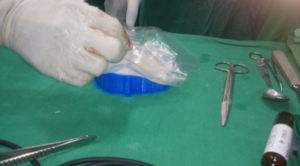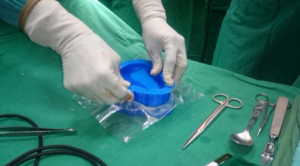Anatomiz3D Creates 3D Printed Cranioplasty Implant Mold to Save Costs on Patient-Specific Healthcare
 In terms of medical 3D printing, one area that always gets a lot of attention is the creation of patient-specific models. It can be very helpful for both patients and surgeons to see a 3D printed patient-specific model, in order to get a good visual of what’s to come in surgical procedures. Obviously, it’s also helpful to go with patient-specific 3D prints when you’re dealing with medical implants. Mumbai-based medical 3D printing company Anatomiz3D LLP, the healthcare division of tech company Sahas Softech, is well-versed in many aspects of medical 3D printing, from prosthetics and surgical and educational models to surgical guides and patient-specific surgical models. But what happens when a patient simply can’t afford patient-specific medical objects, like cranioplasty implants? Jupiter Hospital, also based in Mumbai, turned to Anatomiz3D for the answer to this question, and the company stepped up to the plate, by designing and 3D printing a cranioplasty implant mold.
In terms of medical 3D printing, one area that always gets a lot of attention is the creation of patient-specific models. It can be very helpful for both patients and surgeons to see a 3D printed patient-specific model, in order to get a good visual of what’s to come in surgical procedures. Obviously, it’s also helpful to go with patient-specific 3D prints when you’re dealing with medical implants. Mumbai-based medical 3D printing company Anatomiz3D LLP, the healthcare division of tech company Sahas Softech, is well-versed in many aspects of medical 3D printing, from prosthetics and surgical and educational models to surgical guides and patient-specific surgical models. But what happens when a patient simply can’t afford patient-specific medical objects, like cranioplasty implants? Jupiter Hospital, also based in Mumbai, turned to Anatomiz3D for the answer to this question, and the company stepped up to the plate, by designing and 3D printing a cranioplasty implant mold.
 A young hospital employee became a patient, after he arrived at the hospital in an extremely traumatic condition. The patient presented with multiple fractures, and bones broken into small fragments, in his cranium. Dr. Harshad Purandare, a neurosurgeon at Jupiter Hospital, opened the skull immediately, to first save the patient from immediate risk of fatality. Dr. Harshad was able to safely remove all of the small bone fragments from inside the patient’s cranium, but had to leave him with a giant sagittal craniotomy defect that would require a cranioplasty to fix.
A young hospital employee became a patient, after he arrived at the hospital in an extremely traumatic condition. The patient presented with multiple fractures, and bones broken into small fragments, in his cranium. Dr. Harshad Purandare, a neurosurgeon at Jupiter Hospital, opened the skull immediately, to first save the patient from immediate risk of fatality. Dr. Harshad was able to safely remove all of the small bone fragments from inside the patient’s cranium, but had to leave him with a giant sagittal craniotomy defect that would require a cranioplasty to fix.
Once the patient had initially recovered from his traumatic injuries, Dr. Harshad planned the surgery, which would fill in the open defect in the cranium. He reached out to Anatomiz3D for assistance in the difficult case, and while the Anatomiz3D team first planned to design a titanium 3D printed patient-specific implant, it turned out that the patient would not be able to afford that option. Anatomiz3D’s mission is to aid surgical practices through customizing operative planning and procedures, and the company is dedicated to developing patient-specific implants and prosthetics. But this time, the Anatomiz3D team went a different way, and decided to create an implant material out of cranioplasty bone cement.
“This was our first implant mold (may be the first in India) and we were very nervous, and excited all the same, about seeing the outcome,” Anatomiz3D Co-Founder and CTO Firoza Kothari told 3DPrint.com.
Even if a 3D printed patient-specific implant was out of the question, Kothari, along with biomedical application engineer Devarsh Vyas and business development engineer Samiksha Save, were entirely committed to developing a unique and accurate solution for the case, which would still utilize 3D printing technology but be inexpensive enough so the patient could afford it. After receiving some helpful guidance from Dr. Harshad on how he was planning to use bone cement in the upcoming surgery, the Anatomiz3D team used the Mimics Innovation Suite software to design a mold for the cranial implant; we’ve seen this Materialise-based software used before to assist in complex surgeries.
- Preparation for bone cement molding
- Compression
- Implant output with screws
The implant accurately fit the shape of the patient’s cranial defect, and the variable thicknesses also matched the path of the defect at various areas. The bone cement perfectly fit the patient, providing a more natural look and complementing the shape of the patient’s head.
The outcome was remarkably good, and the patient has recovered well.
“The fact that this worked has opened up so many avenues for aesthetically and functionally accurate alternatives along with the added advantage of them being low cost surgical solutions. We are always in awe as to the solutions 3D printing is capable of providing when other doors seem shut,” Kothari told us.
Anatomiz3D’s cranial implant mold is yet another great example of how 3D printing technology can provide innovative solutions, even if not how you first imagined. Discuss in the Anatomiz3D forum at 3DPB.com.
Subscribe to Our Email Newsletter
Stay up-to-date on all the latest news from the 3D printing industry and receive information and offers from third party vendors.
You May Also Like
Hyliion CEO Thomas Healy on 3D Printing’s Role in the KARNO Generator
While the electric vehicle (EV) market faces an uncertain future, there’s no uncertainty about the fact that greenhouse gas emissions are drastically changing the climate on Earth. Thanks to its...
Attending the ASTM F42/ISO TC 261 Meetings: The Nitty-Gritty of Additive Manufacturing
I never thought I’d be so excited about an event focused on additive manufacturing (AM) standards, but here we are! When I learned that the recent biannual ASTM F42/ISO TC...
World’s Largest Polymer 3D Printer Unveiled by UMaine: Houses, Tools, Boats to Come
The University of Maine has once again broken its own record by unveiling the largest polymer 3D printer in the world. Surpassing its 2019 achievement, the new Factory of the...
Gorilla Sports GE’s First 3D Printed Titanium Cast
How do you help a gorilla with a broken arm? Sounds like the start of a bad joke a zookeeper might tell, but it’s an actual dilemma recently faced by...



































